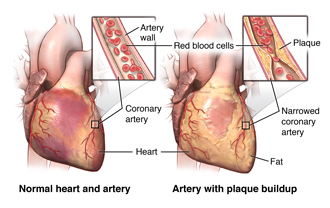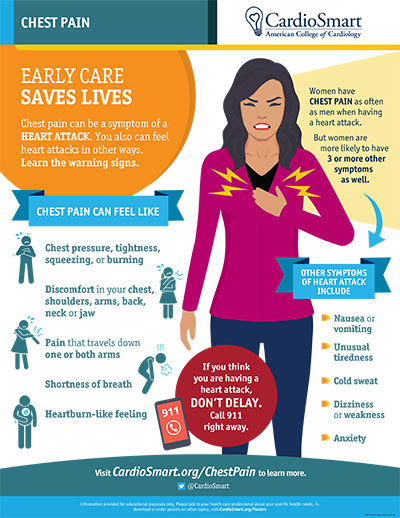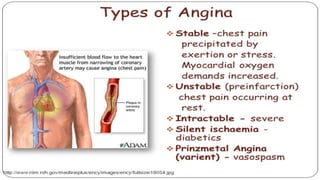Angina Most Often Occurs Due to Which of the Following
The most common cause is reduced blood flow to the heart muscle because the coronary arteries are narrowed by fatty buildups atherosclerosis which can rupture causing injury to the coronary blood vessel resulting in blood clotting which. This is caused by a spasm in the coronary arteries.

Angina Pectoris Johns Hopkins Medicine
Angina is chest pain or discomfort that occurs when an area of the heart muscle does not get enough blood.

. A sense of anxiety or uneasiness. In contrast to stable angina unstable angina. This condition occurs when a part of your heart does not get enough oxygen and blood.
Angina is not a disease but a symptom. Unstable angina or sometimes referred to as acute coronary syndrome causes unexpected chest pain and usually occurs while resting. Stable angina occurs when the heart muscle doesnt get the oxygen it needs to function properly.
Spasms can be caused due to exposure to cold weather stress smoking use of cocaine or taking medications that may tighten or narrow the arteries. This is called unstable angina. It is a common symptom of coronary heart disease which limits or cuts off blood flow to the heart.
Is less frequent but is associated with more pain. Coronary microvascular disease MVD affects small distal coronary arteries. Specialists highlighting the most common causes of angina they call infection.
Angina chest pain called an angina event can happen when. Occurs with a predictable amount of activity or stress and is most common manifestations of CHD. Symptoms of angina include.
Relieved by rest and nitrates. It may also spread to the shoulders arms and or neck. Pressure aching or burning in the neck jaw and shoulders usually the left shoulder and even down the arm.
Angina is chest pain or discomfort that occurs if an area of your heart muscle does not get enough oxygen-rich blood. The chest pain or discomfort associated with angina occurs when an area of the heart muscle does not receive enough oxygen-rich blood. Angina pectoris is the medical term for this type of chest pain.
Often awakens the patient from his or her sleep c. When arteries are severely narrowed angina can also occur at rest. Due to the insufficient blood flow to the heart heart cells are starved of oxygen and begin to die.
Stable angina is less serious than unstable angina but it can be very painful or uncomfortable. Myocardial ischemia associated with abnormalities of the coronary microcirculation 3. Most common and predictable form of angina.
A diet high in saturated fat and cholesterol. The pain may wax and wane. The pain and discomfort in case of variant angina usually occurs at rest and during the night or during the early morning hours.
The coronary arteries that carry blood to the heart become narrowed by plaques which restrict blood flow. Stable angina is a symptom of underlying heart disease and the problem usually stems from coronary artery disease CAD. Indicates that myocardial necrosis has occurred d.
There are several types of angina and the symptoms depend on which type you have. It occurs when the heart muscle has to work harder in order to pump blood. Situations like emotional stress physical exertion and cold temperature may cause angina by interrupting.
Occurs when the work of the heart is increased by physical exertion exposure to cold or by stress. Occurs following periods of strenuous exertion b. Pressure aching or burning in the middle of the chest.
This can restrict the blood supply to the heart muscle and trigger the symptoms of. It occurs when the heart does not receive sufficient blood most probably due to one or more arteries of the heart getting blocked. Coronary heart disease is the most common type of heart disease in adults.
Pericarditis most commonly results from a bacterial or viral infection but may occur after the MI. Most cases of angina are caused by atherosclerosis which is a condition where the arteries become hardened and narrowed due to a build-up of fatty substances that are known as plaques. It usually happens due to ischemia when one or more of the coronary arteries becomes narrow or blocked.
Angina pectoris is the medical term for pain or other discomfort in the chest that is due to coronary heart disease. Angina also termed angina pectoris is a condition characterized by chest pain sometimes severe that is caused by an inadequate blood supply to the heart. A B D E.
Anything that causes the coronary arteries to narrow can increase your risk of angina. Type 1 diabetes and type 2 diabetes. This condition occurs in approximately 15 of clients with MI.
The most common cause of angina is coronary artery disease. The causative agents of the disease can enter the human body by airborne droplets or through common household items dishes cutlery towels. There are many risk factors for coronary artery disease.
It can also occur as a symptom of coronary artery disease and may also be caused due to various other etiological factors. Chest pain occurs in the absence of significant coronary atherosclerosis or coronary spasm 2. Because the pumping function of the heart is compromised by an MI heart failure is the second most common complication.
Angina Pectoris is a medical term for chest discomfort or pain as a result of coronary heart disease. Your heart works harder when you exercise or experience emotional stress. Most often it is just called angina.

Angina Chest Pain Cardiosmart American College Of Cardiology

No comments for "Angina Most Often Occurs Due to Which of the Following"
Post a Comment